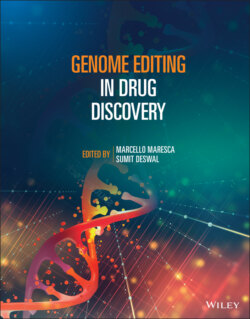Читать книгу Genome Editing in Drug Discovery - Группа авторов - Страница 27
2.7 Novel Genome Editing Technologies
ОглавлениеMost of the initial efforts in genome editing using CRISPR‐Cas9 were mainly reproducing targeting strategies previously demonstrated with Zinc Finger Nucleases and TALENs but at the same time obtaining much better efficiency with an easier design. Several groups showed the use of CRISPR‐Cas9 to promote integration by NHEJ and MMEJ. Joung and Liu´s groups showed that Cas9 could be coupled to FokI to increase its specificity (Guilinger et al. 2014; Tsai et al. 2014). Moreover, transient or stable epigenome editing was demonstrated, following the first demonstration of stable epigenome editing using TALENs (Amabile et al. 2016). The efficiency of the system to induce Gene Knock‐Out and Gene Knock‐In has been really impressive and novel strategies to further enrich for these editing events have been developed recently (Agudelo et al. 2017; Li et al. 2021).
The real differentiator between CRISPR‐Cas9 and the other genome editing technologies is the presence of an exposed single‐stranded DNA after Cas9/gRNA‐mediated strand invasion and target binding (Richardson et al. 2016). This presence of ssDNA is a peculiar characteristic of a D‐Loop‐forming enzyme and is at the base of one of the most relevant CRISPR technology, Base Editing (Komor et al. 2016; Gaudelli et al. 2017). The development of Base Editing, the precise DNA repair system that is using Cas9‐recruited Deaminase to target ssDNA (discussed in Chapter 14), further accelerated the applications of Genome Editing to drug discovery and to Therapeutic Genome Editing. In few years, Base Editing and derived technologies have dramatically impacted the field of functional genomics (Hess et al. 2016; Hanna and Doench 2020) and have provided a safer and more precise alternative to HDR or NHEJ‐based DNA editing In vitro (Webber et al. 2019) and In vivo (Chadwick et al. 2017; Carreras et al. 2019).
Liu´s group, the same group that developed base editing, used the peculiar D‐Loop induction of CRISPR‐Cas9 to develop an additional technology named Prime Editing (Anzalone et al. 2020), where a Reverse Transcriptase is fused to Cas9 to prime a gRNA templated editing event. Prime Editing is still in its infancy, but it will probably expand the reach of base editing.
